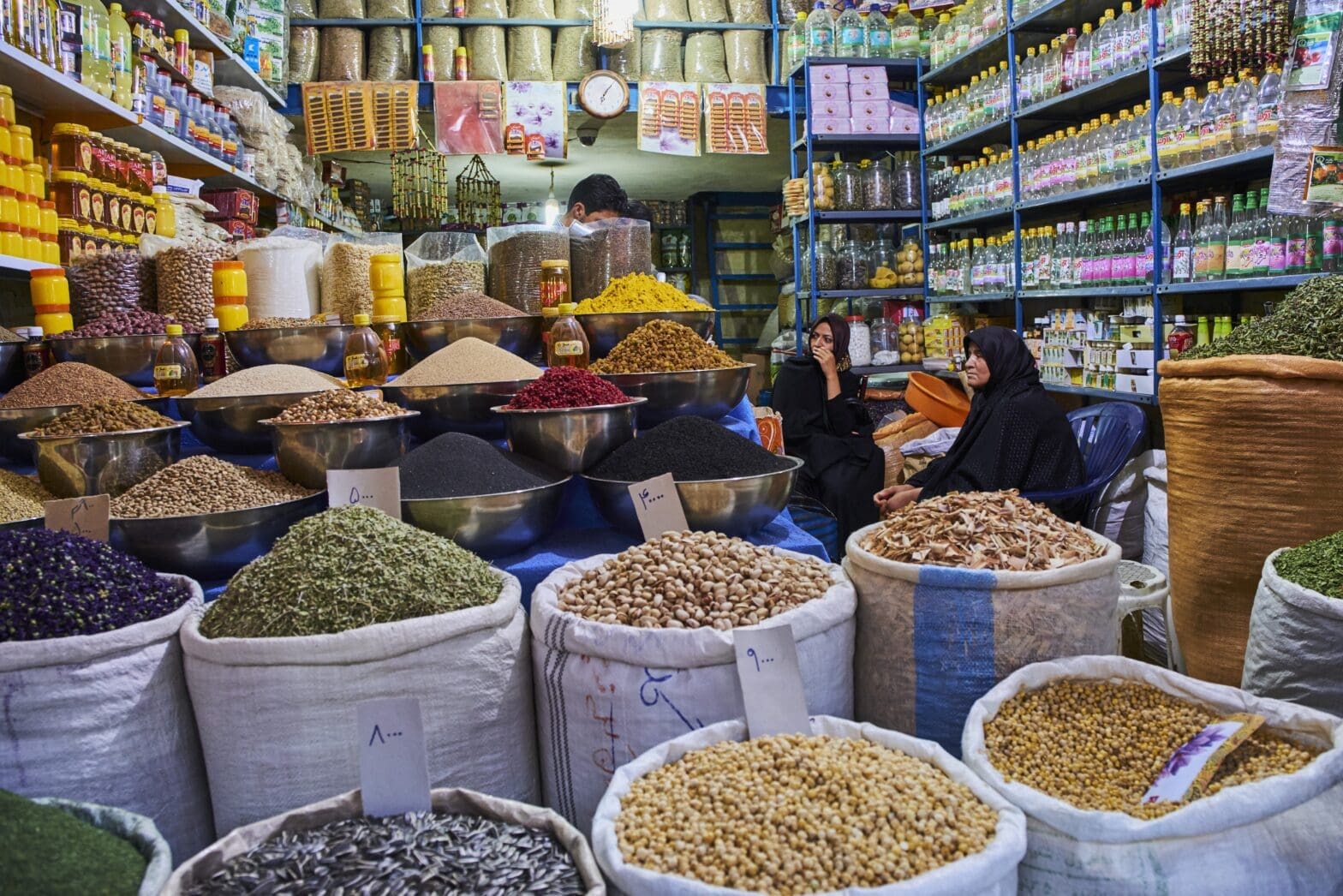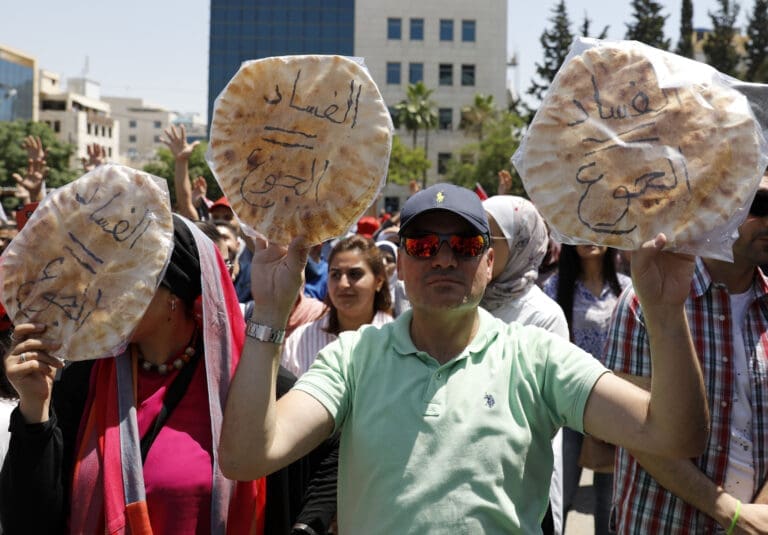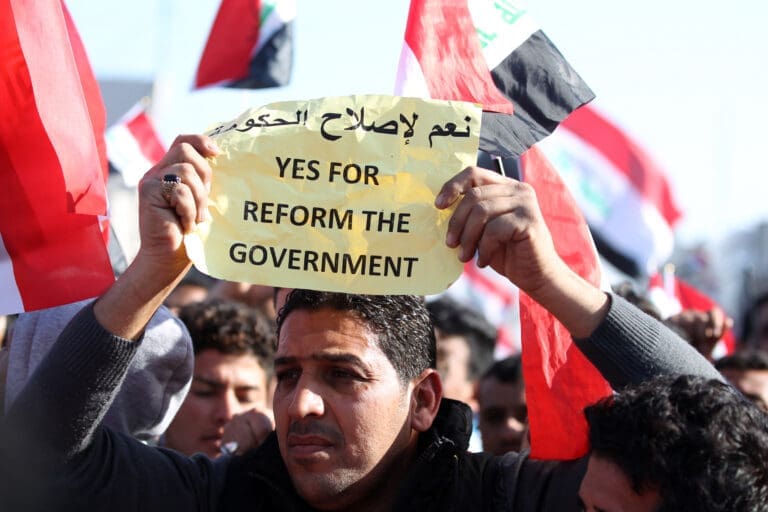
MENA Food Subsidies Are Here to Stay — For Now
Issue Brief, October 2025
Key Takeaways
Food Subsidy Reform Poses a Tough Dilemma: While inflation and shrinking fiscal spaces in many countries across the MENA region are renewing the pressure to transition from subsidies to targeted cash transfers, the region is not yet ready to give up food subsidies.
The Prerequisites to Successful Subsidy Reform Remain Elusive: Given high public demand for subsidies, eroding trust in institutions, and a fragile regional economic outlook, the environment for reform is suboptimal.
Robust Social Safety Nets Are Needed: Despite recent progress, more needs to be done to hone the targeting and expand the coverage of existing social safety nets, before subsidies can be cut.
Energy Subsidy Reforms and Core Issues Come First: Subsidies on energy are far more regressive and costly than subsidies on food, particularly those on staples like bread. Accordingly, reforming energy subsidies should be given precedence and approached in conjunction with broader structural reforms.
Introduction
The Middle East and North Africa (MENA) region has historically relied heavily on subsidies,1 a form of government assistance that entails the provision of select goods or services at below-cost prices.2 Fundamentally a price stabilization mechanism3 and a buffer against the detrimental impacts of economic shocks, subsidies across the region have evolved into instruments of social protection aimed at alleviating poverty and addressing social inequalities, by lowering the cost of living and improving the access of low-income households to food and energy staples.4 In resource-abundant countries, they further serve as wealth redistribution5mechanisms.6 Eventually, such subsidies have transcended their initial purpose of price stabilization and poverty alleviation to one of bestowing legitimacy on regimes, becoming defining features of social contracts in the MENA region.7
In light of volatile commodity prices, heightened inflationary pressures, shrinking fiscal spaces and soaring debt levels, subsidies have proven increasingly challenging to sustain. Beyond fiscal concerns, subsidies have long come under scrutiny by leading international organizations, notably the International Monetary Fund (IMF) and the World Bank, for their regressive nature and inefficiency. Poorly targeted and ill-managed, subsidies mostly benefit the well-off, encourage overconsumption, and divert funding from other critical spending areas.
Many countries across the region have attempted waves of reform since as early as the 1970s, partly prompted by dire fiscal conditions, but mostly under pressure from international lending institutions and donors.8 These reforms have primarily addressed energy subsidies, which became burdensome as energy prices soared and have proven more regressive than food subsidies.
Subsidies on basic food staples remain relatively untouched.9 The region continues to grapple with these reforms, which — while inherently challenging in the context of developing countries — become much more complex in the MENA region given the intertwined socio-economic and political considerations at play.10 Historical examples of food riots across the region attest to the major risk of social unrest posed by attempts to slash food subsidies, particularly for staples like bread.
Leading international institutions have nonetheless continued to advocate for the shift to targeted cash transfers.11 In 2010, Iran slashed bread subsidies and transitioned to a cash transfer scheme.12 In 2018, Jordan substituted its bread subsidies with a targeted assistance program.13 More recently, Egypt has been considering a similar shift towards cash transfers.14
However, regressive as food subsidies may be, the region is not yet ready to transition to targeted cash transfers. The prerequisites of successful and sustainable subsidy reforms — notably, favorable public sentiment, conducive macroeconomic and fiscal conditions, as well as solid governance and accountability frameworks — remain elusive. Above all, while the region has made strides in the realm of social protection, it still needs to bolster the mechanisms required to accurately target the poor, as well as the social safety nets needed to shield them from the detrimental impact of phasing out subsidies.
This issue brief traces the historical evolution of subsidies in MENA and the persistent dilemmas around reforming them. Reflecting on the Iranian reform experience, the brief argues in favor of maintaining food subsidies and concludes by outlining a potential trajectory for reform.
Subsidies in MENA: Historical Context, Fiscal Burdens and the Imperative to Reform
Subsidies were initially introduced to the MENA region in the aftermath of World War II, primarily as price stabilization mechanisms.15 However, they were sustained throughout the post-independence era by incumbent populist authoritarian regimes aiming to consolidate their rule.16 The 1960s and the 1970s witnessed a major expansion of subsidy spending, and by the end of the 1970s, many countries in the region were subsidizing a variety of food staples and energy products, in addition to other services including public transportation and housing.17 Ultimately, subsidies, especially on food staples, became instrumental in shaping social contracts across the region.18 As civil and political rights were increasingly curtailed, regimes progressively emphasized protection and social provision as sources of political legitimacy to compensate for marginal levels of political participation.19
Over time, the budgetary burden of subsidies has soared, owing in part to burgeoning populations, international price fluctuations, and rent-seeking arbitrage opportunities via black markets.20 By 2010, Iran’s subsidy expenditure amounted to more than 20% of the country’s gross domestic product (GDP), reaching a staggering $100 billion.21 In 2012, subsidy spending in Morocco made up 6.6% of GDP, relative to the 5.4% and 5.6% allocated to health and education, respectively.22 In Egypt, subsidies constituted 8.7% of GDP by the fiscal year 2012-2013, as compared to approximately 4.5 and 3.4% for health and education.23
Channeling major fiscal resources to fund subsidies often comes at the expense of productive investments, as well as other vital expenditure areas such as health and education.24 They are further scrutinized for their inefficiency, as well as for the leakages and targeting errors they entail. Above all, the poverty- and inequality-alleviating effects of subsidies have long sparked debate. Household survey data from 2004-2010 and 2003-2009 suggest that across the region, a mere 1-8 % of gasoline subsidies and 1-7% of diesel subsidies accrued to the poor, while 36-86% and 42-77%, respectively, benefited the richest quantile. 25 Meanwhile, 15-25% of food subsidies accrued to the poorest quantiles in Egypt, Iran, Jordan and Lebanon.26
Indeed, untargeted subsidies27 have been demonstrated to favor the rich, with their benefits accruing mostly to higher-income households who account for a greater share of consumption, especially when it comes to energy.28 Rich households tend to consume more energy as they own bigger homes, cars, and electronic devices.29
Reform Attempts and the Case for Food Subsidies
The past two decades have witnessed several reform initiatives across the region. As a result of unfavorable economic conditions, notably soaring food and energy prices and mounting fiscal pressures, several MENA countries have initiated subsidy reforms, mainly targeting energy subsidies. 30
Energy subsidies have been proven to be far more regressive than food subsidies and often account for a greater budgetary burden. In Tunisia, fossil fuel subsidies accounted for nearly 12% of the budget in 2024, compared to 4.1% allocated to cereals, 1.3% to other staples including milk and less than 1% to cooking oil (Figure 1).
Source: Ministry of Finance, Tunisia.31
Budgetary and fiscal concerns aside, even in energy-producing countries, subsidies continue to exhaust resources and to leave a detrimental environmental footprint. Subsidizing energy negates the incentive to cut consumption, deters efforts to transition to cleaner energy sources and make progress on emissions-reduction goals.
Food subsidies, on the other hand, have remained relatively untouched.32 Given the prominence of food expenditures in household spending, reforming these subsidies is inherently politically challenging. Attempts to slash food subsidies — especially for staples like bread — have sparked social unrest, often forcing governments to reverse reforms. Egypt witnessed violent riots in 1977 that came to be known as the “Bread Intifada” following attempts to slash subsidies on staples such as rice, sugar and bread.33 In the mid-1980s, attempts to raise the price of bread in Tunisia — as part of IMF-recommended austerity measures — were revoked after they triggered social unrest.34 In Jordan, food subsidy cuts in 1989 and 1996 were faced with major opposition, while in Morocco the phasing out of food subsidies in 1981 and 1984 triggered violent protests.35
More importantly, food subsidies have been found to be less regressive. Food spending accounts for a greater share of poorer households’ income, and consumption levels tend to be comparable across income brackets, meaning that the benefits accruing to households in higher deciles typically reflect their subjective share of the population.
Leading financial institutions such as the IMF and the World Bank have nonetheless continued urging MENA countries to slash their subsidies and transition to direct cash transfers36,37.
In principle, well-targeted and properly administered cash transfers are more progressive than universal subsidies on food, as they ensure that the majority of benefits accrue to households in lower income brackets.38 Beyond improving nutritional access and alleviating poverty, conditional cash transfers have also been linked to enhanced health and educational outcomes.39 Cash transfer schemes in Sub-Saharan Africa have also proven instrumental in sustaining the livelihoods of beneficiaries, by boosting productive investment, optimizing labor allocation and bolstering households’ resilience to shocks.40
A few countries across the MENA region, notably Egypt, have been debating the transition from universal food subsidies to targeted transfers, while others have introduced cash transfers in conjunction with universal subsidies, with the aim of eventually phasing out the latter. Meanwhile some have already embraced cash transfers, notably Iran. The Iranian experience deserves further examination. As bold and unprecedented as it was, especially for an energy producer, it attests to the perils of premature reforms.
In 2010, Iran embarked on its “Targeted Subsidy Reform” scheme, slashing subsidies on several energy and food staples — notably bread — and introducing unconditional cash transfers.41 Initially, the transfers were successful in improving consumption patterns and nutritional intake levels, and in shrinking the gap between the rich and poor.42 Estimates suggest the poverty headcount index reached 10.6%, down from 22.5%.43 However, these welfare gains were short-lived, as heightened inflationary pressures44, a depreciating national currency, and the lack of an indexation element eventually eroded the purchasing power of the transfers.45 Some analysts argued that the reforms ultimately exacerbated food insecurity and inequality levels.46 Above all, the transfers were costly and inadequately targeted.47 Their value surpassed that of the reform savings, and while originally envisioned for households in lower income brackets, owing to administrative challenges in pinpointing the poor, 80% of the population was eligible upon launch.48 Despite efforts to enhance targeting, it is believed that transfers eventually reached up to 70 million people, or roughly 95% of the population.49
In a bid to address these inclusion targeting errors, in 2022 Iran attempted to transition towards targeted electronic vouchers.50 Yet, given infrastructure development delays and persistently unreliable social protection data, direct cash transfers — initially only meant to be paid out during the early months of the scheme — were sustained beyond that. 51 The transfers fed into already soaring inflation and turned out to be quasi-universal, reaching approximately 75% of the population despite being principally designated for the lowest three deciles.52 The scheme was further associated with welfare losses and is thought to have exacerbated poverty levels.53
The reforms were carefully thought-out and well sold to the public. Nonetheless, the ensuing economic woes diminished hard-earned public trust and halted further price increases. While a new wave of reforms was rolled out in 2014, the state is still struggling with ill-targeted, costly cash transfers.
A Suboptimal Reform Environment
Implementing and sustaining subsidy reforms hinges on several prerequisites, including an acquiescent public sentiment, robust institutional trust, a conducive economic and governance context, and reliable social safety nets. In MENA, these prerequisites remain largely elusive.
Recent public opinion data from the region underscores growing expectations for social provision, alongside eroding trust in institutions. Owing to heightened inflationary pressures — induced by the pandemic and further exacerbated by the Russo-Ukrainian conflict — and worsening food insecurity, survey data from the Arab Barometer suggests that relative to 2022, vast proportions of MENA populations identified subsidies as public spending priorities in their countries, including in Jordan (62%), Lebanon (54%) and Tunisia (39%) (Figure 2). In 2024, 32% of respondents in Tunisia, and 27% in Jordan and Iraq reported often running out of food and not being able to afford more.54 The data further reveal a deepening crisis of trust, with 39%, 36%, 33% of the population in Jordan, Tunisia and Morocco, respectively, and as little as 7% in Lebanon placing “a great deal/quite a lot” of trust in government.55
Source: Arab Barometer, Waves VII (2021-2022) & VIII (2023-2024).56
While critical for broader fiscal consolidation efforts, such reforms are more likely to succeed when implemented in periods of relative monetary and fiscal stability and economic expansion. Inflation started to ease in 2024 across the region, where the median inflation rate reached 2.2%, down from 3.4% in 2023.57 Yet given heightened trade pressures, inflationary risks persist.58 Inflationary pressures aside, the region’s overall macroeconomic performance calls for cautious optimism. Regional GDP growth for 2025 was revised down to 2.6%, from initial projections of 3.8%, amid growing tariffs and retaliatory measures, mounting foreign aid and fiscal uncertainty, and escalating geopolitical instability.59 Despite rebounding in 2023, regional fiscal deficits are widening and forecasted to exceed 3% of GDP in 2025.60 And while lower oil prices are expected to ease pressure on importers’ current accounts, they are expected to exert pressure on exporters’ fiscal balances, as current prices are falling short of fiscal breakeven points61.62 Lastly, a debt crisis has been looming over the region. Debt levels in non-oil-exporting MENA countries are expected to rise to approximately 77% of GDP in 2025.63 Debt risks globally are likely to be further exacerbated by mounting geopolitical uncertainty and the higher borrowing costs this brings about.64
Beyond macroeconomic factors, galvanizing public support for contentious reforms necessitates ensuring that the savings accruing from subsidy reforms are optimally deployed and channeled to the expansion of social safety nets as well as to other areas of social and productive spending. This is contingent upon sound governance frameworks and transparent fiscal management. Fiscal transparency challenges remain persistent across the region, and while the quest for good governance gained momentum post-2011, reforms have stalled overall.65
Above all, securing public buy-in for slashing food subsidies hinges on the reliability of social safety nets and their effectiveness in shielding the vulnerable.
A few countries in the region, notably Egypt, Jordan, Tunisia, and Morocco, have made commendable progress in developing their social protection systems. In 2015, Egypt inaugurated the Takaful and Karama Program (TKP), a cash transfer scheme aimed at shielding households against the repercussions of economic reforms — notably the slashing of energy subsidies in 2014 and the levying of the value added tax (VAT) in 2016. The program, which evolved into the country’s flagship cash transfer scheme, has been fully institutionalized, and its financing reached EGP 41 million66 in 2024, up from EGP 3.6 million in 2015.67 TKP targeted 4.67 million low-income households as of December 2023, up from around 2 million in 2018, reaching 50% of the poor.68 The program eased the risk of falling into poverty, boosted consumption and brought about nutritional, health and educational attainment gains.69 It further stimulated productive investments, eased debt burdens and rendered beneficiary households more shock-resilient.70 TKP was complemented by a number of “cash-plus interventions,” notably Forsa, aimed at economically empowering beneficiaries and facilitating their integration into the labor market.71
In 2024, Jordan’s National Aid Fund (NAF) provided cash assistance to more than 235,000 low-income households, reaching 70% of the country’s poor and lowering poverty levels by 1.4 percentage points.72 Tunisia’s flagship social assistance scheme, Amen, targeted 333,000 low-income households, reaching over 10% of the country’s population.73 In a bid to enhance targeting and delivery efficiency, Egypt, Jordan and Morocco have also moved towards establishing unified social registries.74 MENA social protection systems, too, witnessed major reforms in 2023.75 Several countries initiated structural and legislative reforms to enhance the efficiency, inclusivity and financial sustainability of social protection systems. These included the enactment of new social protection laws in Oman and Iraq, pension and benefit raises in Algeria and Morocco, among others, and efforts to facilitate the integration of the self-employed into contributory social security schemes and promote productive inclusion.76
Nevertheless, social protection systems across the region are lagging overall. While the region is home to 4.6% of the world’s poor, as per the latest statistics from the International Labor Organization (ILO), Arab states allocated 4.6% of their GDP to social protection, compared to 5.1% in South East Asia and the Pacific, 10.6% in Latin America and the Caribbean, 14.8% in Eastern Europe and 12.9% globally.77 The inclusivity of such systems continues to be undermined by the persistent prevalence of labor market informality, and their capacities are increasingly challenged by climate change, political instability, and the economic vulnerability and displacement they bring about. 78 The coverage of pension benefits is suboptimal, driven by patchy social security contributions, while social assistance schemes remain fragmented and constrained.79
Lastly, the transition from subsidies to targeted cash transfers is administratively challenging and bureaucratically demanding. It hinges on reliable ICT infrastructure and the capacity to collect data regularly to estimate and verify and track household incomes, as well as to adjust transfers to correct for inflation. Except for the Gulf Cooperation Council (GCC) states, the MENA region still lags in terms of introducing e-government systems.80 Issues of data availability, quality and timeliness go beyond conflict-ravaged zones, to higher-income countries, notably those of the GCC.81
Trajectories for Reform
Once the region lays the groundwork for subsidy reform, energy subsidies should be targeted before food staples. In fact, compared to food subsidy reforms, previous episodes of energy subsidy reforms were often faced with little to no social backlash.82
The region has made strides in reforming universal energy subsidies. Between 2012 and 2013, Tunisia started gradually phasing out energy subsidies, raising the prices of gasoline and diesel, as well electricity.83 In 2014, electricity prices were adjusted to match consumption levels, and energy subsidies allocated to cement producers were halted.84 In 2012, Morocco initiated the first phase of reforms, liberalizing the prices of gasoline, diesel and fuel oil in 2013.85 Egypt also embarked on energy subsidy reforms in 2014, adjusting the prices of several petroleum derivatives, as well as electricity prices.86 Beyond energy importers, Iran, a major exporter, undertook bold subsidy reforms in 2010, slashing subsidies on several energy products including gasoline and diesel.87 Nevertheless, more remains to be done.
MENA energy exporters and importers alike remain among the heaviest subsidizers globally. Average subsidization rates88 range from 58% in Egypt, 75% in Algeria and a staggering 94% in Libya (Figure 3).
Source: IEA, Fossil Fuel Subsidies Database.89
Reforming energy subsidies would free up fiscal spaces and unlock budgetary resources that could be channeled towards expanding social safety nets and enhancing their targeting.
While reforming subsidies, especially on energy derivatives, is crucial, freeing fiscal space depends equally on reviewing public expenditures and mobilizing fiscal revenues. The proliferation of state-owned enterprises (SOEs) continues to strain MENA economies.90 Beyond crowding out private enterprises, SOEs — often inefficient and poorly managed — drain subsidies and exhaust fiscal resources through bailouts and equity injections.91 When it comes to public revenue mobilization, although many countries across the region have reformed their tax systems, the contribution of taxes to public revenues remains subpar.92 Moreover, the region’s tax landscape is marked by a heavy reliance on regressive taxes (taxes on goods and services) while the potential of income and wealth taxes remains largely untapped.93 Streamlining tax procedures and enhancing their transparency will be crucial for boosting compliance and enlarging tax bases.
Conclusion
Given the public mood, the fragile regional economic outlook, persistent governance gaps, and chronically deficient social safety nets, the MENA region is not currently positioned to overcome its long-standing reliance on subsidies. Priority should be given to fostering an environment conducive to reform, by advancing effective bureaucracies, enhancing the efficiency and agility of public administration, boosting fiscal transparency, containing inflationary pressures, cutting fiscal deficits, and keeping public debt levels in check.
Going forward, the effective phasing out of food subsidies and the sustainability of such reforms will rest, above all, on the capacity to accurately target the vulnerable and adequately compensate them. Expanding the coverage of social safety nets and boosting the sustainability and shock-responsiveness of social protection systems are paramount. While efforts to establish unified social registries are promising, more needs to be done to enhance the availability and quality of statistical data.
Meanwhile, emphasis should be placed on improving subsidy targeting, addressing leakages and distribution inefficiencies, and exploring alternative financing options.
Ultimately, although subsidy reforms will be instrumental for fiscal consolidation efforts, they are no panacea to the region’s woes unless undertaken in conjunction with broader reforms tackling structural inefficiencies.
Endnotes
1 Consumer subsidies are state interventions intended to assist economically vulnerable individuals (consumer subsidies) via the provision of certain goods (food staples, energy products, etc.) or services (public transportation, social housing, etc.) at below-market prices.
2 Carlo A Sdralevich, Randa Sab, Younes Zouhar and Giorgia Albertin, Subsidy Reform in the Middle East and North Africa: Recent Progress and Challenges Ahead, (Washington, DC: International Monetary Fund, 2014), https://www.imf.org/en/Publications/Departmental-Papers-Policy-Papers/Issues/2016/12/31/Subsidy-Reform-in-the-Middle-East-and-North-Africa-Recent-Progress-and-Challenges-Ahead-41548.
3 Subsidies enable governments to prevent the pass-through of international price fluctuations to consumers, by absorbing differentials and keeping prices stable.
4 Paolo Verme, Subsidy reforms in the Middle East and North Africa region: A Review, (Washington, DC: World Bank, 2016), https://documents.worldbank.org/en/publication/documents-reports/documentdetail/260201524137749680/subsidy-reforms-in-the-middle-east-and-north-africa-region-a-review.
5 In resource-endowed countries, subsidies on energy and food staples are among the channels via which governments share natural resource revenues with their citizenries.
6 Sdralevich, Sab, Zouhar and Albertin, Subsidy Reform in the Middle East and North Africa.
7 Verme, Subsidy reforms in the Middle East and North Africa region.
8 Georgeta Vidican Auktor and Markus Loewe, Subsidy reforms in the Middle East and North Africa: Strategic Options and their Consequences for the Social Contract, Discussion Paper, (Bonn, Germany: German Institute of Development and Sustainability, 2021), https://www.idos-research.de/discussion-paper/article/subsidy-reforms-in-the-middle-east-and-north-africa-strategic-options-and-their-consequences-for-the-social-contract/.
9 Verme, Subsidy reforms in the Middle East and North Africa region.
10 Tamar Gutner, “The political economy of food subsidy reform: the case of Egypt”, Food Policy 27 455–476 (2002): 455–476, https://doi.org/10.1016/S0306-9192(02)00049-0.
11 See Federica Alfani, Maria Eugenia Genoni and Johannes Hoogeveen, “MENA: Uniform cash transfers are better than subsidies”, World Bank Blogs, September 19, 2022, https://blogs.worldbank.org/en/arabvoices/mena-uniform-cash-transfers-are-better-subsidies.
12 Dominique Guillaume, Roman Zytek, and Mohammad Reza Farzin, Iran–The Chronicles of the Subsidy Reform, Working Paper, (Washington, DC: International Monetary Fund, July 2011), https://www.imf.org/external/pubs/ft/wp/2011/wp11167.pdf.
13 “Jordan ends bread subsidy, doubling pita prices”, Al Jazeera, January 26, 2018,
https://www.aljazeera.com/economy/2018/1/26/jordan-ends-bread-subsidy-doubling-pita-prices.
14 Reuters, “Egypt edges towards replacement of food subsidies with cash payments,” September 30, 2024, https://www.reuters.com/world/middle-east/egypt-edges-towards-replacement-food-subsidies-with-cash-payments-2024-09-30/.
15 Paolo Verme, “Subsidy Reforms in the Middle East and North Africa Region: A Review,” in The Quest for Subsidy Reforms in the Middle East and North Africa Region: A microsimulation Approach to Policy Making, eds. Paolo Verme and Abdelkarim Araar (Cham, Switzerland: Springer Cham, 2017), 3-31, https://documents.worldbank.org/en/publication/documents-reports/documentdetail/965011495167833904/the-quest-for-subsidies-reforms-in-the-middle-east-and-north-africa-region-a-microsimulation-approach-to-policy-making.
16 Raymond Hinnebusch, “The rise and decline of the populist social contract in the Arab world”, World Development 129, no.1 (2020), https://doi.org/10.1016/j.worlddev.2019.104661.
17 Auktor and Loewe, Subsidy reforms in the Middle East and North Africa.
18 Ibid.
19 Verme, Subsidy reforms in the Middle East and North Africa region; Auktor and Loewe, Subsidy reforms in the Middle East and North Africa.
20 Auktor and Loewe, Subsidy reforms in the Middle East and North Africa; Benedict Clements, David Coady, Stefania Fabrizio, Sanjeev Gupta, Trevor Alleyne, and Carlo Sdralevich, Energy Subsidy Reform: Lessons and Implications, (Washington, DC: International Monetary Fund, September 2013), https://www.elibrary.imf.org/display/book/9781475558111/9781475558111.xml.
21 Verme, Subsidy reforms in the Middle East and North Africa region, 11-12.
22 Paolo Verme, Khalid El-Massnaoui, and Abdelkrim Araar, Reforming subsidies in Morocco, (Washington, DC: World Bank, 2014), 1, https://documents.worldbank.org/en/publication/documents-reports/documentdetail/621831468053942440/reforming-subsi-; World Bank Statistical Database, “Current Health Expenditure (% of GDP),” accessed July 22, 2025, https://data.worldbank.org/indicator/SH.XPD.CHEX.GD.ZS?locations=MA-EG; World Bank Statistical Database, “Government Expenditure on Education, Total (% of GDP),” accessed July 22, 2025, https://data.worldbank.org/indicator/SE.XPD.TOTL.GD.ZS?locations=MA-EG.
23 Sdralevich, Sab, Zouhar and Albertin, Subsidy Reform in the Middle East and North Africa, 93; World Bank Statistical Database, “Current Health Expenditure (% of GDP)”; World Bank Statistical Database, “Government Expenditure on Education, Total (% of GDP).”
24 Paolo Verme and Abdelkrim Araar, The Quest for Subsidies Reforms in the Middle East and North Africa Region: A Microsimulation Approach to Policy-Making, (Washington, DC: World Bank, 2017), 137, https://documents.worldbank.org/en/publication/documents-reports/documentdetail/965011495167833904/the-quest-for-subsidies-reforms-in-the-middle-east-and-north-africa-region-a-microsimulation-approach-to-policy-making.
25 Sdralevich, Sab, Zouhar and Albertin, Subsidy Reform in the Middle East and North Africa, 14.
26 Ibid, 18.
27 In contrast to targeted subsidies which are limited to specific income brackets, societal segments, or geographical locations, untargeted or universal subsidies benefit households across income tiers.
28 Ibid.
29 David Coady and Thomas Richardson, “For Richer, Not Poorer: Energy Subsidies in India,” IMF Blog (blog), June 24, 2013, https://www.imf.org/en/Blogs/Articles/2013/06/24/for-richer-not-poorer-energy-subsidies-in-india.
30 Verme, Subsidy reforms in the Middle East and North Africa region.
31 Tunisian Ministry of Finance, “Mīzāniyyat al-muwāṭin li-sanat 2019” [Citizen’s Budget for the Year 2019], (Tunisia: Ministry of Finance, 2019), 4, https://www.finances.gov.tn/sites/default/files/2019-08/budg_cit_19_pdf.pdf ; Tunisia Ministry of Finance, “Mīzāniyyat al-muwāṭin li-sanat 2020” [Citizen’s Budget for the Year 2020], (Tunisia: Ministry of Finance, 2020), 3-4, https://www.finances.gov.tn/sites/default/files/2020-02/Budget_Citoyen_2020.pdf; Tunisian Ministry of Finance, “Budget Citoyen 2021” [Citizen’s Budget 2021], (Tunisia: Ministry of Finance, 2021), 3-4, https://www.finances.gov.tn/sites/default/files/2021-03/Budget%20Citoyen%202021%20FR.pdf; Tunisian Ministry of Finance, “Mīzāniyyat al-muwāṭin li-sanat 2022” [Citizen’s Budget for the Year 2022], (Tunisia: Ministry of Finance, 2022), 4-5, https://www.finances.gov.tn/sites/default/files/2022-04/Budget%20citoyen%20AR.pdf, ; Tunisia Ministry of Finance, “Mīzāniyyat al-muwāṭin 2023” [Citizen’s Budget for the Year 2023], (Tunisia: Ministry of Finance, 2023), 4-5, https://www.finances.gov.tn/sites/default/files/2023-07/Budget%20Citoyen%202023.pdf; Tunisia Ministry of Finance, “Mīzāniyyat al-muwāṭin 2024” [Citizen’s Budget for the Year 2024], (Tunisia: Ministry of Finance, 2024), 8-9, https://www.finances.gov.tn/sites/default/files/2024-11/%D9%85%D9%8A%D8%B2%D8%A7%D9%86%D9%8A%D8%A9%20%D8%A7%D9%84%D9%85%D9%88%D8%A7%D8%B7%D9%86%20digitale%20%284%29.pdf.
32 Ibid.
33 “Thousands in Egypt Riot Over Price Rise,” New York Times, January 19, 1977, https://www.nytimes.com/1977/01/19/archives/thousands-in-egypt-riot-over-price-rise-students-and-workers.html.
34 James Rupert, “Tunisian Leader Avoids Crackdown After Riots Over Bread Price Rise,” Washington Post, January 8, 1984, https://www.washingtonpost.com/archive/politics/1984/01/08/tunisian-leader-avoids-crackdown-after-riots-over-bread-price-rise/aa8da580-c511-49ce-80fc-bc02faab2ec1/.
35 “Jordan: Revolt in the Desert,” Time, May 1, 1989, https://time.com/archive/6702437/jordan-revolt-in-the-desert/; Serge Schmemann, “In Jordan, Bread-Price Protests Signal Deep Anger,” New York Times, August 21, 1996, https://www.nytimes.com/1996/08/21/world/in-jordan-bread-price-protests-signal-deep-anger.html; James M. Markham, “As Morocco Starts to Gain in War, Nation Erupts,” New York Times, July 4, 1981, https://www.nytimes.com/1981/07/04/world/as-morocco-starts-to-gain-in-war-nation-erupts.html;
Henry Kamm, “Rioting Fomented, Moroccan Asserts,” New York Times, January 23, 1984, https://www.nytimes.com/1984/01/23/world/rioting-fomented-moroccan-asserts.html.
36 Cash transfers are a form of direct monetary assistance, whose distribution is either unconditional, or conditional on households satisfying certain requirements (pertaining to children’s school enrollment and attendance, vaccination, and health checkups, among others).
37 Federica Alfani, Maria Eugenia Genoni, and Johannes Hoogeveen, “MENA: Uniform cash transfers are better than subsidies,” Arab Voices (blog), September 19, 2022, https://blogs.worldbank.org/en/arabvoices/mena-uniform-cash-transfers-are-better-subsidies; “IMF Survey: Costly Mideast Subsidies Need Better Targeting,” International Monetary Fund (IMF), accessed July 22, 2025, https://www.imf.org/en/News/Articles/2015/09/28/04/53/socar051412b.
38 Alfani, Genoni and Hoogeveen, “MENA: Uniform cash transfers are better than subsidies.”
39 Benjamin Davis et al., eds., “From Evidence to Action: The Story of Cash Transfers and Impact
Evaluation in Sub-Saharan Africa,” (Oxford, United Kingdom: Oxford University Press, 2016), https://openknowledge.fao.org/server/api/core/bitstreams/a6e06279-00d7-41c0-8c78-a6df973acf92/content.
40 Food and Agriculture Organization, Cash transfers: Their Economic and Productive Impacts, Evidence from Programmes in sub-Saharan Africa, Policy Brief, (Rome: Food and Agriculture Organization, 2016), https://openknowledge.fao.org/server/api/core/bitstreams/da5c9c37-d0ca-40f9-ba05-64b7d8e065fb/content.
41 Guillaume, Zytek, and Farzin, Iran–The Chronicles of the Subsidy Reform, 14.
42 Mohammad H. Mostafavi-Dehzooei, Djavad Salehi-Isfahani and Masoumeh Heshmatpour, Cash Transfers, Food Consumption, and Nutrition of the Poor in Iran, (Cairo: The Economic Research Forum, June 2020), https://erf.org.eg/app/uploads/2020/08/1598372316_703_1658987_252_isfahani_dehzooei_cash_transfers.pdf; Afsaneh Saeediankia, Sara Emamgholipour, Hamed Pouraram, Abdoreza Mousavi, and Reza Majdzadeh, “Impact of Targeted Subsidies Reform on Household Nutrition: Lessons Learned from Iran,” Iranian Journal of Public Health 52, no.7 (2023): 1504, https://doi.org/10.18502/ijph.v52i7.13253.
43 Ali Enami, Nora Lustig, and Alireza Taqdiri, Fiscal Policy, Inequality and Poverty in Iran: Assessing the Impact and Effectiveness of Taxes and Transfers, Working Paper, (New Orleans: Tulane University, 2016), 22, https://ideas.repec.org/p/tul/wpaper/1605.html.
44 It is worth noting that while heightened inflationary levels were in part attributed to the subsidy reforms, they were further exacerbated by the sanctions imposed on the country in 2011.
45 Georgeta Vidican Auktor and Markus Loewe, “Subsidy reform and the transformation of social contracts: The cases of Egypt, Iran and Morocco,” Social Sciences 11, no. 2 (2022): 85, https://doi.org/10.3390/socsci11020085.
https://www.mdpi.com/2076-0760/11/2/85.
46 Seyyed Safdar Hosseini, Mohammad Reza Pakravan Charvadeh and Habibollah Salami, “The Effect of Subsidy Reform Program on Food Security in Iran,” Iranian Journal of Economic Research 21(67), (2016), 53-82, https://ijer.atu.ac.ir/article_7236.html?lang=en; Fatemeh Mohammadi-Nasrabadi, “Cash Transfer Versus Staple Food Subsidies: An Effective Factor on Food Security and Expenditure of Urban Households in Iran,” Journal of Nutrition and Food Security 8, no. 2 (2023), https://doi.org/10.18502/jnfs.v8i2.12596.
47 Paolo Verme, Subsidy reforms in the Middle East and North Africa region: A Review; Semira N. Nikou and Cameron Glenn, The Subsidies Conundrum, (Washington, DC: United States Institute of Peace, 2010), https://iranprimer.com/resource/subsidies-conundrum.
48 Guillaume, Zytek, and Farzin, Iran–The Chronicles of the Subsidy Reform, 4.
49 Djavad Salehi-Isfahani, Iran’s Subsidy Reform from Promise to Disappointment, (Cairo: Economic Research Forum, 2014), 5, https://erf.org.eg/publications/irans-subsidy-reform-from-promise-to-disappointment/.
50 Bijan Khajehpour, “Deep Data: What Raisi’s ‘Economic Surgery’ Means for Iran,” Amwaj Media, June 1, 2022, https://amwaj.media/en/article/raisi-s-economic-reforms-right-policies-at-the-wrong-time.
51 Ali Akbar Tajmazinani, Challenges for food subsidy reform: lessons learnt from the Just Distribution of Subsidies Scheme in Iran, (Bonn: German Institute of Development and Sustainability, 2024),
https://www.idos-research.de/en/discussion-paper/article/challenges-for-food-subsidy-reform-lessons-learnt-from-the-just-distribution-of-subsidies-scheme-in-iran/.
52 Ibid; World Bank, Iran Economic Monitor: Sustaining Growth Amid Rising Geopolitical Tensions, (Washington D.C., World Bank, 2024), 8, https://documents1.worldbank.org/curated/en/099051007102421530/pdf/IDU-39800829-628d-4b5a-a9f9-728b946987e4.pdf.
53 Mohammad Reza Pakravan-Charvadeh, “Geographical patterns of implementing a government subsidy program: implications for health outcomes and nutrient intake in Iran,” Frontiers in Public Health 12 (2024), 10.3389/fpubh.2024.1354099; Bijan Khajehpour, “Deep Data: What Raisi’s ‘Economic Surgery’ Means for Iran.”
54 Arab Barometer Data Analysis Tool, “The food that we bought did not last and we did not have money to get more,” accessed July 29, 2025, https://www.arabbarometer.org/survey-data/data-analysis-tool/.
55 Arab Barometer Data Analysis Tool, “How much trust do you have in: Government,” accessed July 22, 2025, https://www.arabbarometer.org/survey-data/data-analysis-tool/.
56 Arab Barometer Data Analysis Tool, “Among the following, which should be the top priority for government spending in the coming year?” accessed July 22, 2025, https://www.arabbarometer.org/survey-data/data-analysis-tool/.
57 Roberta V. Gatti, Harun Onder, Asif M. Islam, Jesica Torres, Gianluca Mele, Federico Bennet, Sumin Chun, Rana Lotfi, and Ilias Suvanov, Shifting Gears: The Private Sector as an Engine of Growth in the Middle East and North Africa, (Washington, DC: World Bank, 2025), 16, https://documents.worldbank.org/en/publication/documents-reports/documentdetail/099715404232517870.
58 IMF, Fiscal Policy under Uncertainty, (Washington, DC: International Monetary Fund, 2025), https://www.imf.org/en/Publications/FM/Issues/2025/04/23/fiscal-monitor-April-2025.
59 “Press Briefing Transcript: Middle East and Central Asia Department, Spring Meetings 2025,” International Monetary Fund, accessed July 22, 2025, https://www.imf.org/en/News/Articles/2025/04/24/tr-04242025-mcd-press-briefing-sms-2025; Roberta Gatti, Jesica Torres, Nelly Elmallakh, Gianluca Mele, Diego Faurès, Mennatallah Emam Mousa, and Ilias Suvanov., Growth in the Middle East and North Africa, (Washington, DC: World Bank, 2024), 9, https://openknowledge.worldbank.org/entities/publication/3d15a77f-2cc3-45af-98fa-2fd577b44b69; IMF, Fiscal Policy under Uncertainty; Alex Kozul-Wright, “What would an Israel-Iran war mean for the global economy?” Aljazeera, June 16, 2025, https://www.aljazeera.com/economy/2025/6/16/what-would-an-israel-iran-war-mean-for-the-global-economy.
60 IMF, Fiscal Policy under Uncertainty, 2.
61 The fiscal break-even oil barrel price denotes the barrel price at which an oil-exporting country’s revenues equal their expenses.
62 “Short-Term Energy Outlook”, U.S. Energy Information Administration, accessed August 12, 2025, https://www.eia.gov/outlooks/steo/.
63 IMF, Fiscal Policy under Uncertainty.
64 Ibid.
65 “Open Budget Survey 2023”, International Budget Partnership, accessed July 28, 2025, https://internationalbudget.org/open-budget-survey/open-budget-survey-2023.
66 As of August 19, 2025, 1EGP=0.021 USD.
67 World Bank, “Promoting Inclusive Human Capital Development and Building Resilience in Egypt through Cash Transfer Programs” (Washington, DC: World Bank, May 2024), https://www.worldbank.org/en/results/2024/05/28/promoting-inclusive-human-capital-development-and-building-resilience-in-egypt-through-cash-transfer-programs.
68 Ibid; Ahmed Tammam, Reform of Social Protection In Egypt: Takaful and Karama Programme (TKP), A pro-women programme, (New York: United Nations Children’s Emergency Fund, 2019), 4, https://www.unicef.org/mena/media/4971/file/EGY-SocialProtection-June2019.pdf.pdf.
69 Hagar ElDidi, Hoda El-Enbaby, Yumna Kassim, Sikandra Kurdi, Patti Petesch, Yasmine Moataz, and Karim-Yassin Goessinger, Impact evaluation study for Egypt’s Takaful and Karama cash transfer program, Part 2: Qualitative Report, Working Paper, (Washington, DC: International Food Policy Research Institute, 2018), https://cgspace.cgiar.org/items/0a32125d-c50e-4d91-9a39-38aa7e6a7bc8.
70 Hoda El Enbaby Dalia Elsabbagh, Daniel Gilligan, Naureen Karachiwalla, Bastien Koch, and Sikandra Kurdi, Impact Evaluation Report: Egypt’s Takaful Cash Transfer Program, Second Round Report, Working Paper, (Washington, DC: International Food Policy Research Institute, 2022), https://egyptssp.ifpri.info/2022/09/30/new-publications-impact-evaluation-report-egypts-takaful-cash-transfer-program-second-round-report/.
71 “Furṣa [Chance],” Ministry of Social Solidarity of the Arab Republic of Egypt, accessed July 22, 2025, https://www.moss.gov.eg//ar-eg/Pages/program-details.aspx?pid=11.
72 National Aid Fund, “al-Taqrīr al-Sanawī 2024 [Annual Report 2024],” (Hashemite Kingdom of Jordan: National Aid Fund, 2024), 14, https://naf.gov.jo/EBV4.0/Root_Storage/AR/EB_RelatedItems/%D8%A7%D9%84%D8%AA%D9%82%D8%B1%D9%8A%D8%B1_%D8%A7%D9%84%D8%B3%D9%86%D9%88%D9%8A_2024.pdf.
73 “Enhancing the Social Protection System to Better Serve Vulnerable Populations,” World Bank, accessed July 22, 2025,https://www.worldbank.org/en/programs/teri/brief/enhancing-the-social-protection-system-to-better-serve-vulnerable-populations.
74 United Nations Economic and Social Commission for Western Asia (UNESCWA), Innovation for effective social protection policies, (Beirut: United Nations Economic and Social Commission for Western Asia, 2025), https://www.unescwa.org/sites/default/files/event/materials/10-%20Innovation%20for%20effective%20social%20protection%20policies.pdf; Ahmed Tammam, Reform of Social Protection In Egypt.
75 United Nations Economic and Social Commission for Western Asia (UNESCWA), Annual Digest of Social Protection Reforms in the Arab Region, 2023, (Beirut: United Nations Economic and Social Commission for Western Asia, 2024), https://www.unescwa.org/publications/annual-digest-social-protection-reforms-arab-region-2023.
76 Ibid.
77 United Nations Development Programme (UNDP) and Oxford Poverty and Human Development Initiative, Global Multidimensional Poverty Index 2024, (New York: United Nations Development Programme, 2024),7,
https://hdr.undp.org/content/2024-global-multidimensional-poverty-index-mpi#/indicies/MPI; “World Social Protection Report 2024-26: In figures,” International Labour Organization, accessed July 28, 2025, https://www.ilo.org/resource/article/world-social-protection-report-2024-26-figures.
78 “Social protection in the Arab States,” International Labour Organization, accessed July 22, 2025, https://www.ilo.org/regions-and-countries/ilo-arab-states/areas-work/social-protection-arab-states.
79 Ibid.
80 United Nations E-Government Knowledgebase, “E-Government Development Index,” accessed July 22, 2025, https://publicadministration.un.org/egovkb/en-us/Data-Center.
81 Asif M. Islam, Data Transparency in the Middle East and North Africa, Working Paper, (Washington, DC: World Bank, 2023), https://openknowledge.worldbank.org/entities/publication/963fadd6-eb3b-4e62-8146-309d648f85d3.
82 Verme, Subsidy reforms in the Middle East and North Africa region.
83 Verme, Subsidy reforms in the Middle East and North Africa region.
84 Ibid.
85 Verme, El-Massnaoui, and Araar, Reforming subsidies in Morocco.
86 Tom S. Moerenhout, “Reforming Egypt’s fossil fuel subsidies in the context of a changing social contract,” in The politics of fossil fuel subsidies and their reform, eds. Jakob Skovgaard and Haaro van Asselt (Cambridge: Cambridge University Press, August 2018), 265-282, https://doi.org/10.1017/9781108241946.017.
87 Guillaume, Zytek, and Farzin, Iran–The Chronicles of the Subsidy Reform.
88 As per the price-gap approach, the subsidization rate refers to the price differential (the difference between the reference price of a fossil fuel and the price paid by end consumers) borne by the state.
89 International Energy Agency Fossil Fuel Subsidies Database, “Total subsidy as share of GDP (%)” & “Average subsidisation rate (%),” accessed July 23, 2025, https://www.iea.org/data-and-statistics/data-product/fossil-fuel-subsidies-database.
90 James Colvin and Peter Farup Ladegaard, Governance of State-Owned Enterprises in the Mena Region: Synthesis and Cross-cutting Findings of SOE Governance Reviews of Six Countries, (Washington DC: World Bank, 2024), https://documents.worldbank.org/en/publication/documents-reports/documentdetail/099041724024017229/p17710512063070d01877e17dabd0bc80f0.
91 Ernesto Ramirez Rigo et al., State-Owned Enterprises in Middle East, North Africa, and Central Asia: Size, Costs, and Challenges, (Washington DC: International Monetary Fund, 2021), https://www.imf.org/en/Publications/Departmental-Papers-Policy-Papers/Issues/2021/09/17/State-Owned-Enterprises-in-Middle-East-North-Africa-and-Central-Asia-Size-Costs-and-464657.
92 Jihad Azour, Priscilla Muthoora and Geneviève Verdier, “Middle East Needs Fairer Taxes to Aid Growth and Ease Inequality,” IMF Blog, July 06, 2022, https://www.imf.org/en/Blogs/Articles/2022/07/06/middle-east-needs-fairer-taxes-to-aid-growth-and-ease-inequality.
93 United Nations Economic and Social Commission for Western Asia (UNESCWA), Tax reforms in the Arab Region: Assessing Equity, Efficiency and Progressivity Toward Mobilizing Domestic Resources, (Beirut: UNESCWA, 2023), https://www.unescwa.org/node/45079.




